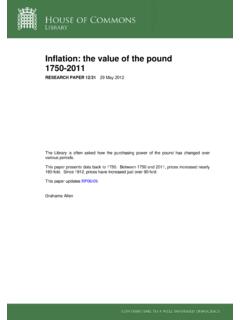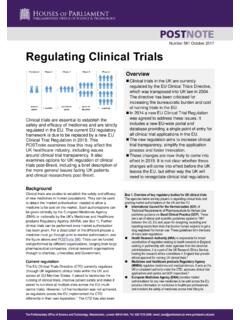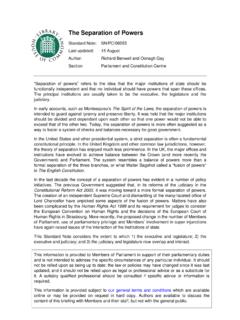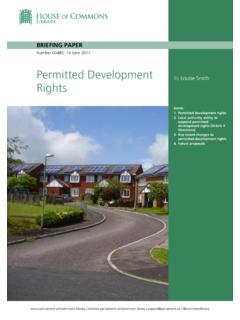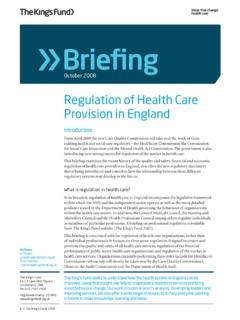Transcription of Construction industry: statistics and policy
1 | | | @commonslibrary BRIEFING PAPER Number 01432, 16 December 2019 Construction industry: statistics and policy By Chris Rhodes Inside: 1. The Construction sector key figures 2. Economic output 3. Jobs in Construction 4. Value of new orders 5. Construction sector policy Number 01432, 16 December 2019 2 Contents Summary 3 1. The Construction sector key figures 4 2. Economic output 5 Performance of the sector since 2007 5 3. Jobs in Construction 7 Self-employment in Construction 8 Regional Construction employment 9 Migrant labour force in Construction 10 4. Value of new orders 11 Sectors in the Construction industry 11 5.
2 Construction sector policy 13 Construction 2025 13 Farmer Review 13 Construction sector deal 14 Construction Sector Deal: one year on 15 Cover page image copyright: Construction , Aldgate by John Wilson. Licensed under CC BY-NC-SA / image cropped. 3 Construction industry: statistics and policy Summary Key statistics In 2018, the Construction contributed 117 billion to the UK economy, 6% of the total. Economic output in 2018 was slightly down on 2017, the first fall since 2013. There are million Construction industry jobs in the UK in Q2 2019, of all jobs. There are more Construction jobs now than at any time since 2007, although throughout this period, roughly the same proportion of jobs have been in Construction .
3 The Construction industry is unusual because of the high proportion of self-employment in the sector 36% in Q2 2019, compared to the average for the whole economy of 13%. New orders to the Construction industry were worth billion in 2017. This is 13% down on 2017, the first fall since 2011. New housing orders accounted for 35% of all Construction orders, commercial orders accounted for 25% and infrastructure orders accounted for 19%. policy The Government s strategy for the Construction sector was set out in Construction 2025, published in 2013. It included the following aims: A 33% reduction in both the initial cost of Construction and the whole life cost of assets (from 2010/09 levels).
4 A 50% reduction in the overall time from inception to completion for new build and refurbished assets (based on industry standards in 2013). A 50% reduction in greenhouse gas emissions in the built environment (compared to 1990). A 50% reduction in the trade gap between total exports and total imports for Construction products and materials (from February 2013 deficit of 6 billion). The Farmer Review, Modernise or Die, which examined labour force and skills issues in the sector was published in October 2016. It made found deep seated structural issues in the sector, including a manpower shortage, a widening skills gap, a poor reputation, inadequate training and a lack of policy and industry oversight.
5 The Farmer Review s recommendations are sweeping, and include: A new system of governance for skills, recruitment and training by the Construction Leadership Council A reformed Construction Industry Training Board Increased R&D spending and incentives to encourage off-site Construction and modern building techniques, particularly in housebuilding. The Framer Review and Construction 2025 informed the Construction Sector Deal (part of the government s Industrial Strategy). The Deal s main policies include: The Construction Leadership Council made up of government officials, academics, Construction firms and Construction clients.
6 It works to coordinate policy in the sector and highlight upcoming challenges The Transforming Construction Programme to lead innovation in methods of Construction , training and recruitment; Support for skill development and retention through a reformed Construction Industry Training Board Improved use of modern Construction methods Improved business practices, including prompt payment of small firms. Number 01432, 16 December 2019 4 1. The Construction sector key figures The Construction sector includes the development and Construction of residential and non-residential buildings; Construction work on civil engineering projects; and specialist Construction activities (such as plumbing and electrical installation).
7 1 The sector does not include activities such as architectural services or project management which often accompany Construction projects. The following table summarises the economic contribution of the Construction sector in Sources: *Output (2018 data): Gross Value Added, ONS, GDP estimates, Low Level Aggregates table; Jobs: ONS, Workforce Jobs via NOMIS Database; Businesses: ONS, Business counts, via NOMIS The Construction sector contributes 117 billion to the UK economy, 6% of total economic output. There are million jobs in the sector, 7% of UK total. There are 343,000 Construction businesses in the UK, 13% of the total (these figures are for registered businesses those that have employees or with turnover above the VAT threshold of 85,000 a year).
8 The Construction sector includes an unusually high number of unregistered businesses which are typically self-employed contractors. 1 Standard Industrial Classification (SIC): Construction is Section F, made up of codes: 41; 42; 43 2 Throughout this paper, the following data sources are used unless otherwise stated: Economic Output (in terms of Gross Value Added, similar to GDP): ONS, GDP estimates, Low Level Aggregates table; Jobs: ONS, Labour Market Bulletin, Tables JOBS03 and JOBS04 (via NOMIS database) Businesses: ONS, Business Counts via NOMIS database.
9 Construction orders: ONS, Construction statistics : Great Britain (annual bulletin) Construction sector in the UK, 2019% of UKEconomic output ( billion)*1176%Jobs (million) (million) Construction industry: statistics and policy 2. Economic output The Construction sector s economic output was 117 billion in 2018, 6% of the UK 2018 saw a slight dip in Construction industry economic output compared to the previous year, the first fall since 2012. Performance of the sector since 2007 Construction sector output fell more significantly during the financial crisis in 2008 and 2009 than the economy as a whole, and has recovered more slowly since then.
10 Construction output grew somewhat in 2010 and 2011 before falling again in 2012 to almost the low seen during the recession in 2009. Between late 2012 and early 2017, growth in Construction sector output was sustained. The sector surpassed its pre-recession peak in Q4 2015. In Q3 2019 output was 12% higher than in Q1 2007 (output in the whole economy has grown by 17% over the same period). Source: ONS, GDP low level aggregates, series KL8A, KL9D Annual data on Construction sector output is presented on the next page. 3 Economic output is measured in terms of Gross Value Added, GVA, which is used to show output of sub-parts of the economy such as industries or regions.




